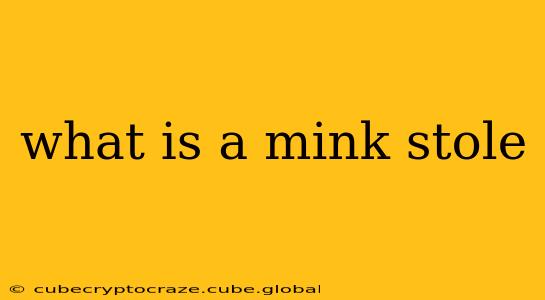A mink stole is a luxurious garment crafted from the pelts of mink, a small, semi-aquatic mammal. Historically a symbol of wealth and sophistication, it's a long, narrow piece of fur typically worn draped around the shoulders or neck. While its popularity has fluctuated over the decades, the mink stole remains a statement piece, representing both elegance and a certain controversial history.
What makes a mink stole so expensive?
The high cost of a mink stole stems from several factors. First, mink farming, though controversial, is a labor-intensive process. Raising, feeding, and preparing the animals for pelting requires significant resources. Second, the quality of the fur itself plays a crucial role. Different mink breeds boast varying shades and textures, with certain colors and qualities commanding higher prices. Finally, the craftsmanship involved in creating a high-quality stole is substantial. Experienced furriers carefully select and sew the pelts together, ensuring a flawless, luxurious final product. The intricate work and superior materials combine to create a substantial price tag.
What are mink stoles made of?
Mink stoles are, as the name suggests, primarily made from the pelts of mink. These pelts are carefully processed to ensure their durability and softness. The tanning process is crucial in preserving the fur's quality and appearance. Different tanning methods can affect the softness and color of the finished product. Additionally, some stoles may incorporate other materials, such as lining fabrics for comfort and support.
Are mink stoles still in fashion?
While mink stoles experienced a peak in popularity during the mid-20th century, their relevance in modern fashion is complex. They've seen periods of decline due to evolving fashion trends and increased ethical concerns surrounding fur farming. However, they remain a coveted item for some, particularly those appreciating vintage fashion or seeking a luxurious, statement accessory. Their presence in contemporary fashion is niche, often appearing in high-end collections or as vintage finds. The sustainability debate surrounding fur has significantly impacted their current market position.
How do I care for a mink stole?
Proper care is essential to preserve the quality and longevity of a mink stole. Experts recommend storing it in a cool, dry place away from direct sunlight and moisture, ideally in a fabric bag to protect it from dust and pests. Avoid using harsh chemicals or excessive brushing. Professional cleaning by a specialist furrier is advisable; at-home cleaning attempts can easily damage the delicate fur. Regular inspection for any signs of wear and tear is also recommended. Keeping it properly maintained can ensure it remains a treasured piece for years to come.
How can I tell if a mink stole is real?
Determining the authenticity of a mink stole requires careful examination. Genuine mink fur possesses a characteristic softness and luster that's difficult to replicate. It feels supple to the touch and has a noticeable "give" when gently pressed. The individual hairs are typically uniform in length and thickness, and the overall appearance is consistent. The presence of a quality maker's label can also provide some assurance. If in doubt, seeking expert opinion from a reputable furrier is always recommended.
Where can I buy a mink stole?
Mink stoles can be purchased from a range of sources, including specialized furriers, high-end department stores, vintage clothing shops, and online marketplaces. However, it's vital to exercise caution when buying online, ensuring the seller's reputation and verifying the authenticity of the product before purchasing. Careful inspection of the item and research about the seller are highly recommended to guarantee a genuine and ethically sourced purchase if that’s a priority.
Disclaimer: This information is for general knowledge and should not be considered professional advice. The opinions expressed are those of the author and do not necessarily reflect the views of any particular organization. Ethical considerations regarding fur farming should be taken into account when considering the purchase of any fur garment.
